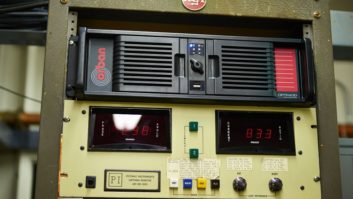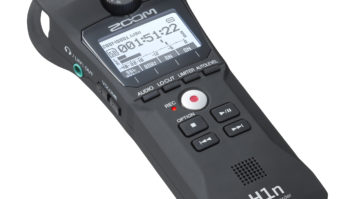PRODUCT CAPSULEAEQ PAW-120 Handheld Digital Recorder
THUMBS UP:
Internal microphones pretty good
Multiple audio formats a plus
Excellent editing capabilities
Good file structure
THUMBS DOWN:
Small display
Some of the parts (such as rubber cover on battery slot) may not last long
PRICE: $699
CONTACT: . AEQ in Florida at (800) 728-0536 or visit www.aeqbroadcast.com
Just a decade or so ago, field recordists were faced with a difficult decision: either shell out for an expensive tape- or digital-based unit, or settle for the chintzy sound and limited feature set that cassette recorders offered. There was not much middle ground.
Today, a number of companies offer portable recorders for little more (adjusting for inflation) than you paid for a top-of-the-line cassette recorder 10 or 15 years ago. The AEQ PAW-120, which can be found online for about $650, is more expensive than some of its competitors. But it offers much more than simple record/playback functionality, and its feature set may be just what you need.
Palm pilot
PAW stands for palm audio workstation, and it’s an apt moniker. At 4.5 x 2 inches, the unit is about the size of a chocolate bar. The PAW-120 can be powered in three ways. In my studio I used the included USB cable to draw power from both my Mac- and Windows-based computers.
To test the recording quality of the internal microphone I loaded up a couple of AA batteries and recorded my son Brian’s band in rehearsal. The PAW-120 burns through a pair of AAs in about two hours, so users also might consider the third option, rechargeable batteries.
The manual is straightforward and fairly well written, but it uses the smallest fonts I’ve ever come across. While on the subject of language, I went up to the AEQ Web site to make sure I had the most recent software version, only to discover that the link is written in Chinese. AEQ, a Spanish company, does have an office, which includes tech support, in Florida.
Navigating through the 120’s feature set, which includes a hierarchical folder structure that functions like Explorer found on a PC, is simple. On a unit this size, the LED screen is small — less than two inches square — but it is well lit. I found myself easily scrolling through the menus, and even executing edits on the fly, after spending about an hour with the 120.
The 120 lets you decide how you want to work. You can, for example, choose one of four audio compression settings, tell the unit that you’re recording in mono or stereo, select either the internal microphone or an external mic, and then name and save these settings in one of 10 Template locations. If your recordings have different audio requirements, say a conference one day and a concert the next, being able to call up Templates is handy.
The 120 comes with a mini-plug to XLR adapter that lets you record with either one or two external microphones. The unit supports dynamic, capacitor and electret microphones, but they must be supplied with phantom power.
Making the band
I started testing the 120 by recording a series of short audio clips in my studio. I chose the “STENO” setting for these quick verbal entries and selected the internal microphone. As you would expect, the STENO sampling frequency (8,000 Hz) is the lowest of the four settings from which to choose, as are the bit rate and file format algorithms. After recording a few short clips I decided to check out the editing function of the 120, and in the process ran into an interesting problem.
By default the 120 names file sequentially (USER004.WAV, USER005.WAV, etc.). After recording a :40 file in which I left room between sentences and dropped in markers while recording, I went into the Manager and renamed the file. Next I went into the Edit page and took a look at the waveform. The markers were clearly visible, and I proceeded to follow the directions for deleting the area between a pair of them. However, I couldn’t perform the edit.
I called tech support and learned that renaming a file locks it in place; no further edits are allowed. I suppose this is okay, but the manual made no mention of this point and I’m sure others will be confused by this omission until AEQ revises the manual.
Unlike some other recorders, the 120 does not use removable flash cards. The 512 MB internal flash memory is sufficient for almost any application you’d reasonably expect. Whether it will hold up over a long period is an open question.
Recording my son’s band in the field I switched over to the highest-quality setting. There are a few quirks to the 120, and one of them is that the “Music” setting — for some reason the second best, not the first, of audio quality settings — is misspelled. Choose “Lusic” if you want this one. I also used the internal, mono microphone for this field test.
Setting up levels is easy, thanks to the 120’s Pre-Record mode. Feng Shui, as the boys call themselves, recorded a four-minute instrumental, which I brought back to my studio and transferred to my PC. When you connect the 120 to a computer via a USB cable, the device asks you if you want to draw power from the computer or transfer a file to it. If you choose to use your computer as a power source you have to remove the cable before the 120 can power down, which I thought was a bit odd.
I opened up the file in Steinberg’s Wavelab 6, trimmed the ends and had a listen. The sound was serviceable. A pair of high-quality microphones would be helpful, of course, but the mono recording the internal mic yielded was a true image of this three-man supergroup’s talent.
In essence, the PAW-120 is a good little recorder with some useful editing features that will come in handy for anyone who doesn’t need a sync track. If your roving reporter is covering a breaking story and wants to make sure obtained quotes are accurate, the PAW-120 will serve his or her needs far better than a cassette deck.








